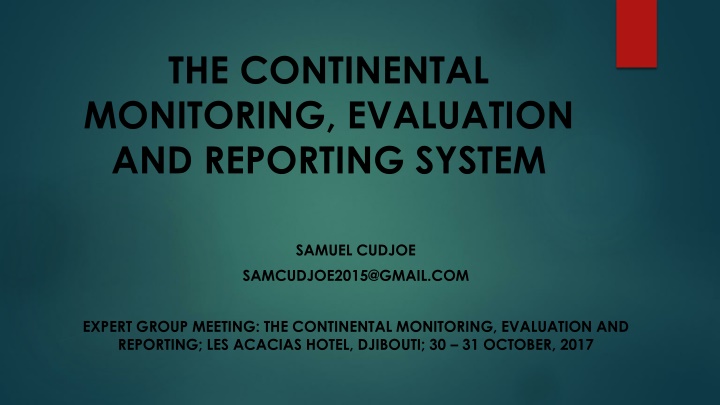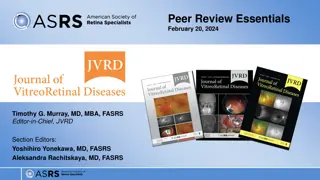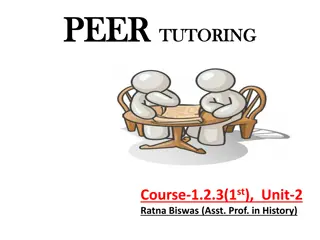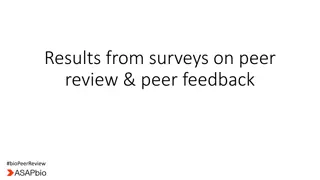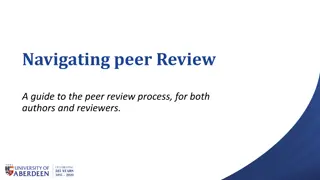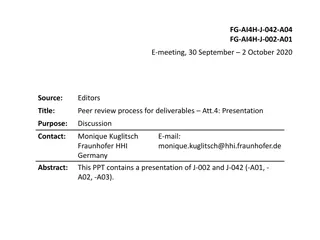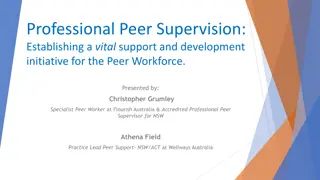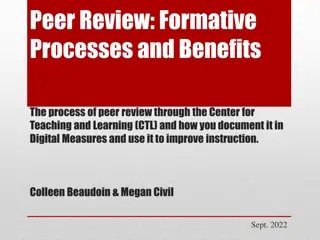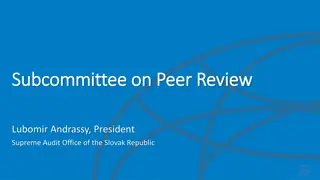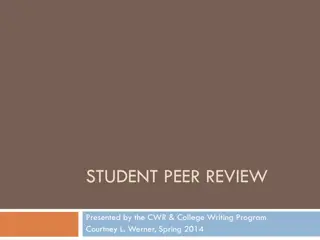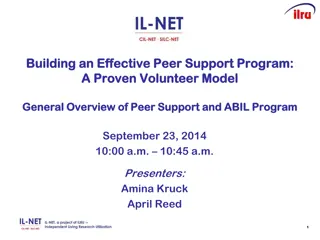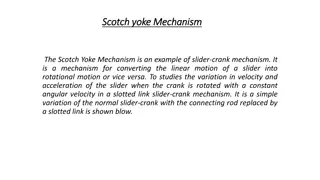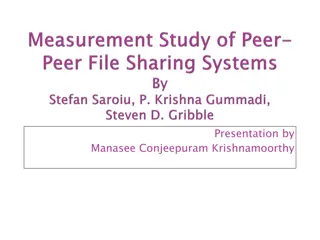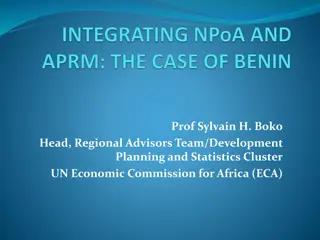African Peer Review Mechanism: Fostering Good Governance
The African Peer Review Mechanism (APRM) is a self-monitoring tool fostering political stability, economic growth, and good governance in Africa. It aims to ensure policies conform to agreed values and standards for sustainable development and integration. The APRM's essential elements include voluntary accession, peer learning, and commitments to democratic processes and institutional building.
Download Presentation

Please find below an Image/Link to download the presentation.
The content on the website is provided AS IS for your information and personal use only. It may not be sold, licensed, or shared on other websites without obtaining consent from the author.If you encounter any issues during the download, it is possible that the publisher has removed the file from their server.
You are allowed to download the files provided on this website for personal or commercial use, subject to the condition that they are used lawfully. All files are the property of their respective owners.
The content on the website is provided AS IS for your information and personal use only. It may not be sold, licensed, or shared on other websites without obtaining consent from the author.
E N D
Presentation Transcript
THE CONTINENTAL MONITORING, EVALUATION AND REPORTING SYSTEM SAMUEL CUDJOE SAMCUDJOE2015@GMAIL.COM EXPERT GROUP MEETING: THE CONTINENTAL MONITORING, EVALUATION AND REPORTING; LES ACACIAS HOTEL, DJIBOUTI; 30 31 OCTOBER, 2017
THE AFRICAN PEER REVIEW MECHANISM
The APRM APRM A Self-Monitoring Tool The APRM is the mutually agreed instrument for self-monitoring by the participating member governments. Mandate The mandate of the African Peer Review Mechanism is to ensure that the policies and practices of participating states conform to the agreed political, economic and corporate governance values, codes and standards contained in the Declaration on Democracy, Political, Economic and Corporate Governance
The APRM Purpose of the APRM The primary purpose of the APRM is to foster the adoption of policies, standards and practices that lead to political stability, high economic growth, sustainable development and accelerated sub-regional and continental integration through sharing of experiences and reinforcement of successful and best practice, including identifying deficiencies and assessing the needs for capacity building. Guiding Principles Every review exercise carried out under the authority of the Mechanism must be Technically competent, Credible, and Free of political manipulation.
The APRM Essential elements of the APRM: voluntary accession; mutual support and targeted capacity building; peer learning, shared values and standards; commitment to fostering good governance practices and democratic processes; and building institutions to actualise these commitments and monitor and assess progress in implementing reform
APRM - Origin Structural Adjustment Programmes imposed by the Bretton Woods institutions made modest progress in improving governance (1970s and 1980s) Public acknowledgement by African leaders that good leadership and good governance were important for development and eradication of poverty (1990s) Initiated a number of institutions Africa Union (AU), Pan African Parliament, the New Partnership for Africa s Development (Nepad) and the African Peer Review Mechanism (APRM). NEPAD merger of the Millennium Partnership for the African Recovery Programme (MAP) (Mbeki, Obasanjo, Bouteflika) and the Omega Plan for Africa (Abdoulaye Wade)
APRM - Origin NEPAD was initially envisaged as a voluntary club for reformist African countries that would improve governance systems in exchange for more development support and investment But NEPAD was later adopted as the economic blueprint of the AU and so lost its voluntary nature APRM became the voluntary tool for monitoring
Role in African Governance A key component of the African Governance Architecture The overall political and institutional framework for the promotion of governance Compliance with Standards and Codes These instruments include the African Convention on Preventing and Combating Corruption (ACPCC) and the African Charter on Democracy, Elections and Governance (ACDEG. Compliance with NEPAD objectives The APRM is also based on participating states' compliance with the NEPAD nine objectives in the area of democracy and good political governance
Strategies to measure performance Identifying issues Country Self Assessment Peer review has significant diagnostic potential Initiating Reforms National Programs of Action ratifying standards and enacting legislation to overhauling policy and strengthening institutions Accountability framework Political space for civic participation Involvement of citizens in policy formulation and evaluation of programmes Documenting best practices for peer learning
CURRENT MER AT NATIONAL AND CONTINENTAL LEVELS
Existing MER Systems National MER Systems comprehensive national monitoring and evaluation frameworks and plans have been developed to monitor national development plans managed and coordinated by Ministries of Planning/Planning Commissions and the National Statistical units track the progress of implementation of a number of initiatives including the Agenda 2030, Agenda 2063, NEPAD and APRM At the local level, the Policy Planning, Monitoring and Evaluation Directorates of the various Ministries, together with the Regional and District Planning and Coordination Units play a key role in ensuring the monitoring of the various initiatives
Existing MER Systems Institutional Arrangements overall oversight and demand accountability for national development plan implementation Parliament/ Inter MC ensure initiatives are captured in the national development plans National Technical Committees Coordination at the sectoral level Ministerial Clusters Coordination/ data management Regional Committees Coordination/ data management District Committees
Existing MER Systems Challenges: Weak demand for and utilization of MER results Limited resources and budgetary allocations for MER Weak capacity Lack of incentives, rewards and sanctions Non-compliance with MER reporting timelines and frameworks Poor data quality, data gaps and inconsistences Inadequate management information systems and networks
Existing national level APRM MER systems Some countries rely on existing MER systems within National Development Planning Ministries/Commissions to collect data to report on NPOA indicators NGC NDPC Statistical Service Line Ministries Central Bank CSOs
Existing national level APRM MER systems Other countries have developed MER systems that collaborate with existing MER systems within line ministries to collect data to report on NPOA indicators. Line Ministries Central Bank NDPC NGC Statistical Service CSOs
Existing national level APRM MER systems The third category is where the NGC Secretariat is located within the National Development Planning Commission/Ministry and thus rely exclusively on existing systems to collect data for APRM indicators NDPC (NGC) Statistical Service Line Ministries Central Bank CSOs
Scope of MER and Communication in APRM MER for APRM starts from the Country Self-Assessment phase of the mechanism. The CSAR constitutes more than the baseline survey of the APRM. It is the diagnosis and identification of enabling factors and binding constraints to development within a country. It entails multiple stakeholder interactions to collect information and data to address the indicators listed in the APRM Base Questionnaire
Scope of MER and Communication in APRM Key MER challenges Capacity constraints in APRM countries monitoring systems influence data availability and quality at all levels national, regional/county and district. For some countries, there are no regular, reliable country data on many key indicators that are needed in order to monitor governance or the progress made towards the NPoA implementation. In addition, administrative data are often inadequate to produce reliable figures on the proposed indicators Institutional and coordination frameworks for MER Funding and budgeting for MER Failure to budget for MER implies the NGCs are unable to undertake both routine monitoring and evaluative activities. Planning for MER Most NGCs fail to use the relevant tools for planning activities, deadlines, success indicators and required financing.
Continental MER Framework and its value addition MER at the continental level is coordinated by the Knowledge Management, Monitoring and Evaluation Division. The KMM&E division relies on progress reports to ascertain the level of implementation of the NPoAs at the country level and to also distill important lessons learned and commendable practices. The KMM&E is currently developing an electronic based MER system to enable it collect real-time data from country MERs
Continental MER Framework and its value addition The continental MER system is being developed with the following principles in mind: Alignment and Synergy Strengthening of existing MER systems already in place at the national and continental levels Leads to maximization and efficiency of resource use Ownership and Participation Highlight the active participation of all relevant stakeholders at both national and continental levels Highlight central roles played by national development planning units and statistical authorities
Continental MER Framework and its value addition Partnership building Need to promote partnerships with CSOs, technical and research institutions, strategic partners, etc Value addition through engagements (both political and technical), financial support, advocacy and sensitization Use of common platforms to track indicators
Continental MER Framework and its value addition Value Addition. Together with the national level MER frameworks, gives practical meaning to the commitment of Africa leaders to improve governance A key tool for the Mechanism to measure progress at all levels sub- regional, national, continental National and sub-national: facilitates tracking of short, medium and long- term changes in governance and service delivery within national development plans Provides empirical data for national planning authorities for policy formulation Continental level facilitates the tracking of progress towards compliance with standards and codes, NEPAD objectives (and Agenda 2063 and Agenda 2030 goals)
Continental MER Framework and its value addition Fostering peer learning within and among member states The distillation of commendable practices coupled with reflective meetings promotes the adoption of good practices (and prevents re- inventing the wheel) Strengthens the ties between AU-AGA, NEPAD, and APSA At both the national levels and continental level the is a reliance on respective institutional arrangements for data collection, information sharing and reflective meetings Promotes participation and ownership Both national and continental frameworks encourage the active participation of all stakeholders to achieve the objectives of the APRM
THANK YOU VERY MUCHFOR YOUR ATTENTION
PLANNING FOR THE CONTINENTAL APRM MER
Planning approaches and tools Planning approaches Bottom-up approach The NGC should ensure that it undertakes extensive consultations and engagements at both the sub-national and regional levels to ensure the buy-in and support of majority of the key stakeholder groups. Iterative approach Planning is an iterative approach, therefore before a plan is approved a number of assessments, alternative considerations and revisions will have to be made. Flexible approach Flexibility means leaving room for future adjustment, modification or revision
Planning approaches and tools Inclusivity At the country-level the NGC shall endeavor to engage with as many stakeholder groupings as is practicable and feasible (giving limitations on resources) Planning Tools Stakeholder Analysis matrix The selection of which stakeholders to involve in development of the MER should be undertaken with a Stakeholder Analysis matrix. Theory of Change It is important to ensure that all those involved in the development of the MER system have a common understanding of the APRM context. This includes arriving at a shared vision of the expected results that the NPoA is trying to achieve and the steps required to achieve them.
Planning approaches and tools M&E Plan or data collection plan The NGC should develop a data collection plan that considers the following issues: Who will be responsible for data collection and supervision? Who will be responsible for ensuring data quality at each stage? How will data quality be checked at each stage? How often will data be collected, compiled, sent and analysed? What indicators will be derived from each data source? How will the data be sent (raw/summary)? What tools/forms will be used, if any? What resources (staff, supplies, computers, transportation, etc) will be needed at each stage? Who will analyse the data? How often will analysis occur? How often will the results be compiled into reports? To whom and how often will results be disseminated?
Smart indicators, baseline and target setting SMART Indicators Country-level indicators At the country-level the indicators to be measured will be derived from the reviewed APRM Questionnaire 1) descriptive indicators that demand a description of a situation or change and provide information not connected to a concrete target (for example, potential sources of conflict in your country); 2) performance indicators that are linked to a reference value or target (for example, maternal mortality rate per 1000 births); 3) contextual indicators that provide a broader view of certain conditions and external factors that may influence the ability of a national government to achieve its goals (for example, Gross Domestic Product or score of Freedom House Index); 4) custom indicators which are unique indicators for tracking progress in a specific country (for example, processes for passing a specific law);
Smart indicators, baseline and target setting 5) standard indicators that produce data that can be aggregated and compared across countries (percentage of population living on less than US$2.50 a day); 6) composite indicators compiled from several indicators which are aggregated and weighted according to an underlying theoretical model (for example, Human Development Index).
Smart indicators, baseline and target setting Continental-level indicators At the continental-level it is proposed that the Knowledge Management and M&E Division will monitor two main types of indicators standard and composite indicators. This proposal is because standard and composite indicators will afford the APRM the opportunity to assess progress across different countries. This does not preclude the inclusion of descriptive indicators. The indicators were selected based on several criteria: (i) maximum data availability, (ii) applicability in broad range of country settings, (iii) broad coverage of goal priorities It should be understood that these metrics do not measure the full range of governance challenges in Africa, and they should not be misunderstood as doing so. They are just a basis for getting started quickly through a rapid self-assessment .
Smart indicators, baseline and target setting It is proposed that the number of indicators be: Limited in number (2 3 per question) but capturing core elements of each objective Applicable to broad range of country settings Recent high-quality data available for as many countries as possible Consensus based, in line with international standards and system-based information Constructed from well-established and accessible data sources
Smart indicators, baseline and target setting Gender-based indicators Gender mainstreaming in APRM Monitoring, Evaluation and Reporting system is a strategy to promote gender equality and respect for human rights, particularly women s and children s rights, and to enhance the protection of all women, regardless of ethnic, social, or religious background. This strategy entails not just disaggregating indicators by sex (such as school enrolment disaggregated by sex) but by developing gender-specific indicators (such as number of women holding senior legislative and managerial positions) that will be monitored over time.
Smart indicators, baseline and target setting Baselines The Country Self-Assessment Report (CSAR) and the Country Review Report (CRR) provides the baselines information on all (or most) of the key APRM indicators for each country. Target Setting Realising the differences in development levels and capacities amongst APRM countries, the mechanism has generally avoided establishing specific benchmarks or targets for the indicators but rather recommends that State parties should set specific benchmarks or targets for themselves in the National Plans of Action. The importance of the progressive realization of the indicators concerned, underlines the use of qualitative as well as quantitative data to assess adequately the progress over time.
Smart indicators, baseline and target setting Continental level MER The continental MER should be guided by the baseline data submitted by countries through their respective CSARs. The APRM has not set out key targets for countries to meet and hence the continental MER should be guided by the targets set by both the Agenda 2063 and the Agenda 2030
Risk management General risks at Country-level Risk Risk assessment Mitigation Failure of NGCs to secure sufficient funding for monitoring, evaluation and reporting could lead to an inability to provide the necessary data to feed the continental e-system. Low organizational capacity of NGC to conduct monitoring and evaluation moderate Continuous between Focal Points, governments and development partners high-level political dialogue Impact: high Unlikely NGCs should collaborate and rely on data generated by existing M&E systems Impact: moderate High Political manipulation of M&E reports The NGCs should assert their independence through legislation Impact: high High Data gaps (especially for Agenda 2063 and 2030 indicators) NGCs institutional arrangements put in place at national level to collect such data should collaborate with Impact: high
MONITORING AND EVALUATION FOR APRM
Monitoring and Evaluation for APRM Information gathering and management The determination of the information that needs to be gathered to enable the APR Secretariat and National Governing Councils track progress will be informed by the following (M&E Plan): An assessment of what information can be realistically collected, given available human and financial resources; For each information need for indicator, there should be an elaboration of the ways information will be collected and organized; Details of who to use what information and which method to gather/synthesize what information; Schedule of frequency of information collection, when, place of collection, persons to be involved, expected information product; Existence of technical and resource feasibility of information needs, indicators and methods; Existence of formats for data collection and synthesis.
Monitoring and Evaluation for APRM Data collection The NGC would collect data annually (or as the case may be) to populate each indicator. Activities during this period include collecting (a) administrative data from various institutions (line ministries, departments, agencies, statistical commissions, central banks, CSOs, etc); (b) conducting national public/household opinion surveys; (c) expert surveys; (d) reviewing documents (narrative reports, legislation and results of surveys and assessments previously conducted).
Monitoring and Evaluation for APRM Assessing the data There is the need for the NGC to assess the quality and usefulness of the data. At the minimum the NGC should ensure the following: Data must be recent the various data collected must all be recent. NGCs should aim to use only administrative data that refer to a time period that precedes other data collection activities (surveys, observations, etc) by no more than 12 months. Data must not contain many missing cases or much missing information Data must cover the entire country and time period (especially for baseline surveys during the Country Self-Assessment). Data must not be politically compromised maintaining political neutrality is essential, albeit often difficult in some countries where the political situation can be tense and the cultures of transparency and accountability are likely to be weak.
Monitoring and Evaluation for APRM Analyzing data Once the NGC has populated the e-system of the continental APRM Secretariat with the necessary data, they may use the system to undertake data analysis for the preparation of their progress reports.
Monitoring and Evaluation for APRM Continental level Data collection To centrally collect data on standard indicators from APRM countries, the Knowledge Management and M&E Division is setting up a computerised reporting system (e-system) to which participating countries have to be report and update on a regular basis. Improving data availability and quality Ensuring data quality and availability is among the main problems faced by the Knowledge Management and M&E Division when collecting data on standard indicators from APRM countries, Adopt strategies such as carrying out regular data quality reviews to detect irregularities, asking for documentation, performing random checks and using external forms of assurance.
Monitoring and Evaluation for APRM Analyzing data Developing indicator ratings When the NGC has collected and submitted information for at least two successive time periods (Country Self-Assessment and Country Review Report, and first progress report), the Knowledge Management and M&E Division can measure and describe change in three ways: dynamic ratings that compare current findings with the results from the previous round of data collection indicating positive change, negative change, or no change. Narrative descriptions that provide contextual information to aid in the interpretation of ratings and include information that is not captured elsewhere Trend data, summarizing the results of all rounds of data collection, to show recent changes as well as change over a longer period of time.
Monitoring and Evaluation for APRM Data verification Data Verification Audit tool The overarching aim of this tool is to strengthen the quality of data reported by the APRM countries. The tool is designed to: Determine the accuracy of historical data reported; Facilitate identification of specific root causes of inaccurate data; Build capacity of staff of M&E units of the NGC Secretariats in reporting high quality data;
